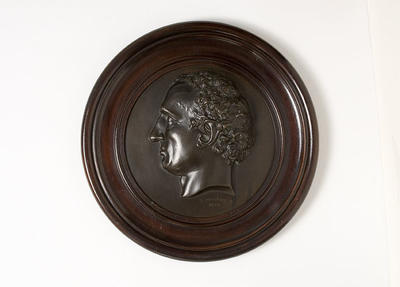Medallion
Maker & role
Thomas Woolner (b.1825, d.1892), Sculptor
Production date
1854
See full details
Object detail
Title
Edward Hamilton
Production place
Collection
Measurements
Medallion, Diam: 22cm (Diam: 220mm); Frame & Medallion, Diam: 32.5cm (Diam: 325mm)
Subject person
Signature & marks
- Inscribed lower centre: 'T. Woolner, Sc. / 1854'
- Clyde Bank label (printed & handwritten label) on lower centre of reverse: 'CLYDE BANK/ 43 LOWER FORT STREET,/ THE ROCKS, SYDNEY 2000/ TELEPHONE: (02) 9241 4776/ FACSIMILE: (02) 9251 4991' (printed). ‘Mis 5 / ThomAs WooLNeR 1825-1892 / PORTRAiT MedaLLioN / SiR EdwARd WiLLiAm TeRRick / HamiltoN (1809-1898) / 1854’ (handwritten).
- Artworld Shipping label (printed & handwritten label) in lower left corner of reverse: ‘Mr B Venus / (1 of 6)’ (handwritten). ‘ARTWORLD SHIPPING LTD / Ryland House, Ryland Road, London NW5 3EH / Telephone. 0171482 8308 Fax. 0171267 5309’ (printed). ‘20224221/1’ (handwritten).
- Sotheby’s label (printed & handwritten) on upper left of reverse: ‘27186/2 OF 6’ (handwritten). ‘SOTHEBY’S / FOUNDED 1744’ (printed).
- Handwritten label on masking tape, centre of reverse: ‘EDWARD WILLIAM / TERRICK HAMILTON’.
- Clyde Bank label (printed & handwritten label) on lower centre of reverse: 'CLYDE BANK/ 43 LOWER FORT STREET,/ THE ROCKS, SYDNEY 2000/ TELEPHONE: (02) 9241 4776/ FACSIMILE: (02) 9251 4991' (printed). ‘Mis 5 / ThomAs WooLNeR 1825-1892 / PORTRAiT MedaLLioN / SiR EdwARd WiLLiAm TeRRick / HamiltoN (1809-1898) / 1854’ (handwritten).
- Artworld Shipping label (printed & handwritten label) in lower left corner of reverse: ‘Mr B Venus / (1 of 6)’ (handwritten). ‘ARTWORLD SHIPPING LTD / Ryland House, Ryland Road, London NW5 3EH / Telephone. 0171482 8308 Fax. 0171267 5309’ (printed). ‘20224221/1’ (handwritten).
- Sotheby’s label (printed & handwritten) on upper left of reverse: ‘27186/2 OF 6’ (handwritten). ‘SOTHEBY’S / FOUNDED 1744’ (printed).
- Handwritten label on masking tape, centre of reverse: ‘EDWARD WILLIAM / TERRICK HAMILTON’.
Credit line
Gift, through the Australian Government’s Cultural Gifts Program, 2004
Caroline Simpson Collection, Museum of Sydney Collection, Museums of History New South Wales
Caroline Simpson Collection, Museum of Sydney Collection, Museums of History New South Wales
Caption
Edward Hamilton (1854)
Description
Bronze portrait medallion in bas relief of Sir Edward William Terrick Hamilton (1809-1898) by Thomas Woolner, 1854. During the mid nineteenth century the portrait medallion had heroic associations and was seen as a public, rather than a private art form. The ability to produce multiple casts, in different mediums, created a viable market in the colony for these images. Apart from private family ownership, these portraits were also sought after by colonists of ‘a nationalist persuasion’.
English sculptor Thomas Woolner (1825- 1892) trained in the studio of William Behnes, one of Britain’s eminent sculptors, before leaving England in 1852 to try his luck on the Victorian goldfields. After limited success he returned to his original profession seven months later. Early in 1854 Woolner moved to Sydney and, after receiving widespread acclaim for his portrait medallion of William Charles Wentworth, his work was much in demand by clients who were landowners, government officials, civil servants, professionals and merchants.
Sir Edward Hamilton was born in England but abandoned a legal career to migrate to New South Wales. From 1843-46 he held a seat on the Legislative Council of NSW. In 1851-1854 he was the first Provost of the University of Sydney and served as governor of the Australian Agricultural Co. from 1857-1898. In 1855 he returned to England with his family but retained connections with the colony by becoming its representative agent in London in 1863. In 1865-1869 Hamilton represented Salisbury in the House of Commons and was sheriff of Berkshire in 1879. He died on 28 September 1898, predeceased by his wife and survived by two sons and six daughters.
Woolner’s portraits followed the traditions of Renaissance medallic sculpture which drew upon the form of the Roman medal but his work was noted for his accuracy in modelling realistic detail. The Australian casts were originally in plaster and no evidence has been found to indicate that the reliefs were ever locally cast in bronze. When Woolner returned to England in 1854, he took several of these plaster reliefs for casting in bronze. These Australian medallions drew attention to his merits as a portraitist and he continued to work successfully in this genre on both private and major public commissions. In 1874 he was elected to the Royal Academy and taught briefly as Professor of Sculpture between 1877-1879.
English sculptor Thomas Woolner (1825- 1892) trained in the studio of William Behnes, one of Britain’s eminent sculptors, before leaving England in 1852 to try his luck on the Victorian goldfields. After limited success he returned to his original profession seven months later. Early in 1854 Woolner moved to Sydney and, after receiving widespread acclaim for his portrait medallion of William Charles Wentworth, his work was much in demand by clients who were landowners, government officials, civil servants, professionals and merchants.
Sir Edward Hamilton was born in England but abandoned a legal career to migrate to New South Wales. From 1843-46 he held a seat on the Legislative Council of NSW. In 1851-1854 he was the first Provost of the University of Sydney and served as governor of the Australian Agricultural Co. from 1857-1898. In 1855 he returned to England with his family but retained connections with the colony by becoming its representative agent in London in 1863. In 1865-1869 Hamilton represented Salisbury in the House of Commons and was sheriff of Berkshire in 1879. He died on 28 September 1898, predeceased by his wife and survived by two sons and six daughters.
Woolner’s portraits followed the traditions of Renaissance medallic sculpture which drew upon the form of the Roman medal but his work was noted for his accuracy in modelling realistic detail. The Australian casts were originally in plaster and no evidence has been found to indicate that the reliefs were ever locally cast in bronze. When Woolner returned to England in 1854, he took several of these plaster reliefs for casting in bronze. These Australian medallions drew attention to his merits as a portraitist and he continued to work successfully in this genre on both private and major public commissions. In 1874 he was elected to the Royal Academy and taught briefly as Professor of Sculpture between 1877-1879.
Accession number
MOS2005/10



Public comments
Be the first to comment on this object record.